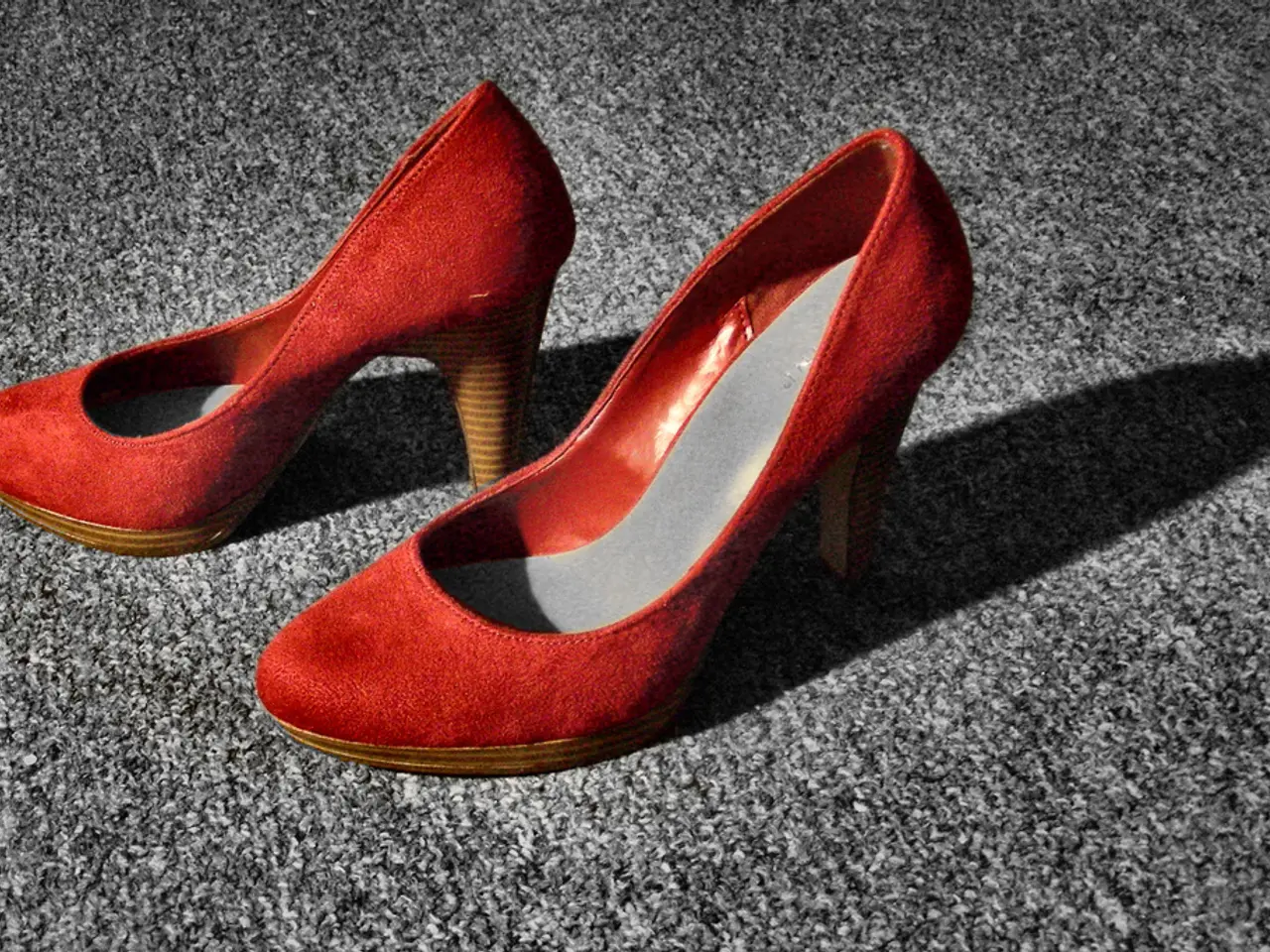Remedies for Split Heels:
Cracked heels can be a painful and uncomfortable condition, but with the right care and treatment, it can be managed effectively at home. Here's a guide to the most effective home remedies for treating and preventing severe cracked heels.
Foot soaks are a great starting point. Soaking feet in warm water softens hardened skin, improves blood circulation, and prepares the feet for exfoliation. Adding ingredients like Epsom salt or vinegar can help disinfect and soothe the skin. Lemon juice mixed with sugar can act as a natural scrub to break down dead skin, but it should not be used on open cracks as it may cause burning[1].
Regular exfoliation is essential to remove thick dead skin. Use gentle scrubs such as oatmeal mixed with rose water or alum powder, which acts as a natural exfoliator. A foot file or pumice stone can also be used to file away rough, dry skin. However, it's important to remember that feet should be dry before filing to avoid worsening cracks[1][3][5].
After exfoliation, deeply moisturize the feet with natural oils (like coconut or olive oil) or specialized foot creams to seal in moisture and prevent the skin from drying out and cracking again[2]. Wearing 100 percent cotton socks to bed after applying petroleum jelly to the heel may help to keep the moisture in, allow the heel skin to breathe, and prevent bed sheets from becoming stained.
Prevention tips include maintaining regular foot care by soaking and moisturizing daily, wearing comfortable, breathable footwear, avoiding prolonged barefoot walking, and protecting feet from harsh conditions. Keeping feet clean and dry also prevents infections, which can worsen cracked heels[1][2][4].
Using a pumice stone gently on moisturized thickened skin can help reduce thickness and calluses. However, people with diabetes or neuropathy should not use pumice stones and should instead visit a dermatologist or podiatrist[6].
If self-treatment does not improve cracked heels after a week, people should see a podiatrist or dermatologist. In severe cases, cracked heels can cause discomfort or pain, and may become infected[7]. Liquid, gel, or spray bandages can provide a protective layer over cracked skin, reduce pain, prevent dirt and germs entering wounds, and aid faster healing.
The American Academy of Dermatology recommends applying an ointment or cream containing lactic acid, urea, hyaluronic acid, glycerin, dimethiconol, lanolin, petrolatum, or mineral oil for dry skin[8]. If the cracks in the heels are deep, they can be painful, hurting when a person stands up, and may sometimes bleed. In such cases, medical treatments may be necessary, which may include removal of dead skin, prescription of stronger softening or removal agents, application of medical glue to seal cracks, prescription of an antibiotic if there is an infection, strapping the heel with dressings or bandages, recommendation of shoe inserts, heel pads, or heel cups, and help with changing how a person walks[9].
Home remedies for cracked heels also include moisturizing treatments, gentle use of a pumice stone, and applying a keratolytic. Keratolytics help thin the skin, cause the outer skin layer to loosen, and help with the removal of dead skin cells[10].
According to the National Foot Health Assessment 2012, 20 percent of adults in the United States have experienced cracked skin on their feet, with women being 50 percent more likely to report the condition than men[11]. Dry skin is usually the cause of cracked heels, and various factors can increase the risk, such as standing for long periods on hard flooring, obesity, open-back shoes, poorly fitting shoes, friction from the back of shoes, a poor way of walking, dry, cold weather, diabetes, psoriasis, eczema, flat feet, athlete's foot, fungal infections, heel spurs, hypothyroidism, Sjögren's syndrome, juvenile plantar dermatosis[12].
In summary, the best home treatment for severe cracked heels combines warm foot soaks, gentle exfoliation with foot files or natural scrubs, and consistent moisturizing with oils or creams, along with preventive care to maintain healthy, supple skin on the feet[1][2][3][5].
[1] American Academy of Dermatology. (2021). Cracked heels. Retrieved from https://www.aad.org/public/diseases/a-z/cracked-heels-prevention-and-treatment [2] Healthline. (2021). How to treat cracked heels at home. Retrieved from https://www.healthline.com/health/cracked-heels-home-treatment [3] Mayo Clinic. (2021). Cracked heels: Self-care. Retrieved from https://www.mayoclinic.org/diseases-conditions/cracked-heels/self-care/hwb-20057608 [4] National Health Service. (2021). Cracked heels. Retrieved from https://www.nhs.uk/conditions/cracked-heels/ [5] WebMD. (2021). Cracked heels: Causes, treatments, and prevention. Retrieved from https://www.webmd.com/skin-problems-and-treatments/cracked-heels-causes-treatments-prevention [6] American Diabetes Association. (2021). Foot care: Prevention and treatment of foot problems. Retrieved from https://www.diabetes.org/healthy-living/medication-treatments/foot-care [7] Mayo Clinic. (2021). Cracked heels: When to see a doctor. Retrieved from https://www.mayoclinic.org/diseases-conditions/cracked-heels/symptoms-causes/syc-20361203 [8] American Academy of Dermatology. (2021). Dry skin: Causes, symptoms, and treatment. Retrieved from https://www.aad.org/public/diseases/a-z/dry-skin-prevention-and-treatment [9] American Podiatric Medical Association. (2021). Cracked heels. Retrieved from https://www.apma.org/patients/footcare/footproblems/Pages/Cracked-Heels.aspx [10] Healthline. (2021). Keratolytics: Uses, side effects, and precautions. Retrieved from https://www.healthline.com/health/keratolytics [11] National Foot Health Assessment. (2012). Cracked heels. Retrieved from https://www.ncbi.nlm.nih.gov/pmc/articles/PMC3623364/ [12] American Podiatric Medical Association. (2021). Risk factors for cracked heels. Retrieved from https://www.apma.org/patients/footcare/footproblems/Pages/Cracked-Heels.aspx
- For disinfection and soothing, consider adding ingredients like Epsom salt, vinegar, or lemon juice (but avoid lemon on open cracks) to foot soaks.
- Maintaining regular foot care, such as daily soaking and moisturizing, can help prevent cracked heels.
- Wearing breathable footwear and avoiding prolonged barefoot walking can also help in preventing cracked heels.
- People with conditions like diabetes or bipolar disorder, or those who have sensitive skin conditions such as psoriasis or eczema, should exercise caution when using foot files or exfoliating agents, and may need medical advice.
- Aside from foot soaks and exfoliation, moisturizing treatments like coconut or olive oil, foot creams, and even sensitive skin-care products like moisturizers containing lactic acid or hyaluronic acid can be beneficial.
- If self-treatment is ineffective or if the condition worsens, it's essential to consult a podiatrist or dermatologist, as cracked heels may progress to painful, infected, or deep cracks that require medical intervention.
- Health-and-wellness products like keratolytics can help thin the skin, loosen dead skin cells, and aid in the effective removal of dead skin.
- Certain factors such as standing for long periods on hard flooring, obesity, open-back shoes, friction from the back of shoes, a poor way of walking, dry, cold weather, cancer, athlete's foot, fungal infections, hepatitis, or health conditions like diabetes, Sjögren's syndrome, or hypothyroidism can increase the risk of experiencing cracked heels.




